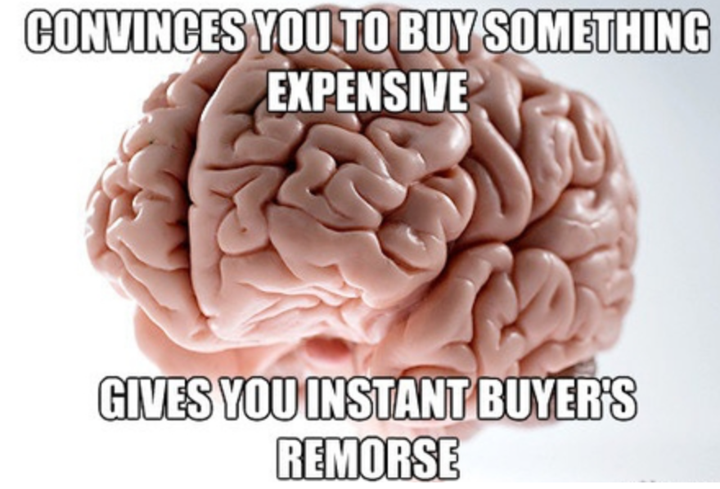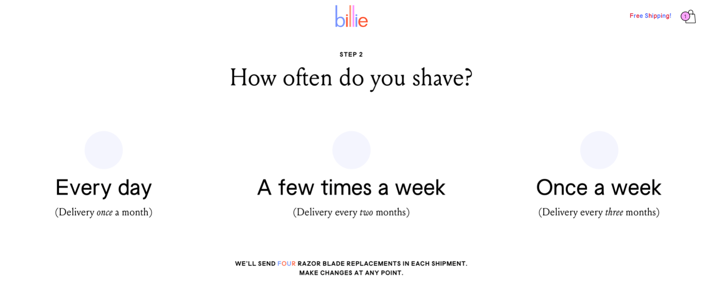What is Post Purchase Dissonance? (+ Examples)

Last week I bought a skincare tool online that I knew I shouldn’t have. I am a total skincare junkie and am constantly researching the hot new cleansers, serums, and trendy tools that I can use in an attempt to have the silkiest smooth skin of the influencer who prompted me to try said tool. But here’s the thing, I have used many (and I mean many) face sculpting tools online over the years and not a single one has worked for me. I don’t know if my face is impervious to being sculpted or if I’m just using the tools wrong or what, but the moment I finalized that order I knew I would regret it.
Cut to— 3 to 5 business days later when my package arrives, I lather my face up in all the recommended oils and creams, go to town on my cheekbones and…. nothing. Once again I found myself to have been sucked in by a flashy targeted ad and a promise of looking like Angelina Jolie circa 2001. My face wasn’t sculpted, but it was overcome with regret.
If this has never happened to you, please DM pronto with your secrets to success! But if it has, you’ll recognize his particular flavor of regret as post purchase dissonance.
The enemy of ecommerce marketers, post purchase regret stings, but there are strategies to prepare your shoppers and alleviate some of those feelings, resulting in happier customers and repeat purchasers.
What is post purchase cognitive dissonance?
To put it plainly: post purchase cognitive dissonance is when you make a purchase and once the purchase is finalized you begin to regret it afterwards. While this is by no means a brand new phenomenon, it has been heightened in more recent years thanks to the online shopping boom.
Anyone have a fun drunk Amazon purchase regret story? Turns out drunk purchasing is...a $45B a year market. Yep you read that right. Fun facts from The Hustle’s survey that found that info include that Baby Boomers are the most likely to drunk shop and the alcohol that fuels the most purchases? Liquor. Should have guessed. Are we going to start seeing wine pairings with our favorite retail websites? I don’t hate it.
With ecommerce stores, customers make their purchases based on the look and feel of product pages and the company website. It has never been easier to make purchases, so brands need to make sure shoppers are armed with as much info as possible so they can make informed online decisions. Then, brands need to give shoppers more tools (like instructional emails) to be successful with their products— replacing an in-person demo or explanation of the item.
And of course, all post purchase dissonance is not the same, everyone who feels it feels it for their own specific reason depending on their personal economic and emotional standing. Some of the most common forms are:
- Poor quality— this could refer to the product itself once you’ve received it or the online shopping experience in general (like if the website was glitchy, your order was delayed, or you didn’t receive customer support when you asked for it).
- Expectations are not met— I’m the first one to admit when my expectations are too high (I’m still trying to figure out why putting on a pair of Calvins didn’t immediately transform me into Kendall Jenner?) but without detailed product descriptions, lots of pictures, and extensive customer reviews to read before making an online purchase, it’s easy to feel burned when you receive your product and it doesn’t live up to how it was presented to you online.
- Impulse buys— the leading cause of post purchase dissonance is making a purchase without all of the necessary information. Sometimes this means the product page was misleading, but more often than not it is due to the customer (sorry, but it’s true!) not doing enough research before finalizing their order.
With total ecommerce revenue in the U.S. is projected to surpass $740B by 2023, and with 82% of adults last year saying that they have regretted purchases they made in the past, that is a whole lot of online shopping gone wrong. Luckily, there are many ways to overcome post purchase dissonance as a shopper. And for all my ecommerce managers and strategists out there, don’t worry, there is a lot you can do as well to help your customers make informed decisions that they won’t regret.
Post Purchase Dissonance vs Buyer’s Remorse

Source: TheStorypedia
If post purchase dissonance sounds a lot like buyer’s remorse to you, you’re not alone. But in reality, buyer’s remorse is just one type of post purchase dissonance. You know how all squares are rectangles, but not all rectangles are squares? It’s like that. All buyer’s remorse is post purchase dissonance, but not all post purchase dissonance is buyer’s remorse.
Still confused? Let’s go over some examples of post purchase dissonance to clear this up even further.
Post Purchase Dissonance Examples
Remember when I said that not all post purchase dissonance stems from the same reason? Well, not all post purchase dissonance manifests itself in the same form every time either. We all have different responses when we find ourselves less than satisfied with our most recent orders. In addition to the always popular falling to your knees and shouting “Why me!?” up at the sky in regret, here are some examples of the most common forms of post purchase dissonance.
Buyer’s Remorse
Let’s start off with a big one: buyer’s remorse. Oof, this one hurts. Typically in response to expensive, luxurious purchases but one that can also hit anyone who has made an impulse buy without taking the time to research the product before hand, buyer’s remorse is most common for customers who purchase things like:
- Houses
- Boats
- The latest tech tool
- Pool and hot tubs
- Extravagant kitchen gadgets
- Instruments
While there are many more than happy hot tub and vintage guitar owners out there, making a purchase of this scale on a whim without doing the required research first is an easy way to put yourself on the fast track to regretsville.
Interestingly, many people rushed to buy homes during the pandemic. A recent Wall Street Journal article explored how people (present company included) were enticed by the stir-craziness of the lockdown combined with insane interest rates into bidding on homes, often well above asking price. Now, people are starting to regret their “Covid homes.” (Don’t worry, present company was unsuccessful, ~no regrets~ over here.)
Making a Return
The first thing many people who experience post purchase dissonance do is check the return policy on their purchase. For people who like to try to recreate the in-person shopping experience when they are online shopping by purchasing multiple sizes or types of products to try on with the intention of returning the unwanted ones (I’ve used this technique more than a few times), making a return is less about post purchase dissonance and more about using returns as a shopping resource.
However, for people with post purchase dissonance, there is nothing that adds to your regret more than ecommerce stores with hidden, unsatisfying return policies or none at all. To minimize return policy pile-on for customers who regret their purchase, make sure you have made it as easy as possible for customers to access policy information and make returns.
Not Renewing a Subscription
There are many reasons why you would choose not to renew a subscription: dissatisfaction with the products, no more use for the product, or an overload of products. To keep your subscription customers happy and subscribed, create flexible subscription options.

Source: Billie
Razor subscription service, Billie, offers three different subscription options for their customers— as well as the option to change their subscription, pause it for a month or two, or unsubscribe at any time. With this level of subscription flexibility, Billie is able to be intuitive about what their customers need to be satisfied and stay subscribed for the long haul.
Cancelling a Free Trial
Offering a free trial period to your customers is a great way to earn their trust. Free trials announce to potential buyers, “Come check us out, we have nothing to hide!” and are often worth the offer. Free trials are a proven way to increase conversion rates, with an average of 57% of users ultimately purchasing a subscription after the trial period ends.
To ease potential post purchase dissonance for customers participating in a free trial period, ensure that at any time they have the option to easily cancel their trial. Sure, this means that you have lost a paying customer, but it also means that they are leaving with good grace still intact— as opposed to if they felt forced to continue their trial, which could result in them...
Leaving a Bad Review
The boogeyman in the closet of every ecommerce organization, bad reviews are the oft feared enemy of ecommerce managers everywhere. But here’s the good news: bad reviews are just an opportunity for you to flex your customer service muscles and turn a negative experience for a customer into a positive one for all parties.
Of course, having more good reviews on your site than bad ones is the goal. But the truth is, you don’t want only good reviews. 68% of shoppers trust reviews more when they can see both positive and negative ones. Hear me out! Ultimately, this is because bad reviews build credibility for your organization. If every single product in your ecommerce store had 1,000 glowing 5 star reviews, it would seem like something fishy was going on there. Instead, when you let your customers read a collection of honest, mixed reviews written by real past-purchasers they are more likely to trust you and your products more.
Tips to Reduce Post Purchase Regret for your Customers
If you feel bummed out about this whole phenomena so far and are thinking that there’s no way to avoid it, wait just a second! Remember that the majority of purchases are not regretted and there are many ways to overcome, reduce, and even eliminate post purchase regret for your customers, like:
- Understanding exactly what leads to post purchase dissonance for your customers. Take the time to go back over any bad reviews, negative-skewing customer surveys you’ve collected, and customer service records to find out each and everything that leads to your customers having regret for their purchases. Respond to negative reviews or comments with thoughtful messages from your team and answer any questions posed.
- Providing your customers with all of the information they need to make informed purchases. This can look like, offering product guides, explanatory videos, and an overview of product uses so once the product has arrived at their doorstep they are prepped and ready to put it to its intended use.
- Making your customer feel taken care of pre and post-purchase. Your customer should never have to look far for customer support, especially when they are in the process of making a purchase. To remind your customers that you have their best interests in mind, remember to show them often that you have their back.
- Consistently optimize your post-purchase experience. Be sure to always provide close follow up communication after making a sale at every step of the post-purchase process (but not too close, we don’t want to overwhelm our customers!) so that they feel supported at all times.
- When communicating with your customers, use personalization to form a more in-depth bond with them— especially when customers contact your customer support team.
- Regularly audit your website to ensure all information is up to date and that the UX experience is seamless. Outdated info can be a red flag to customers who might think that you aren’t maintaining your ecommerce store regularly.
- Be available to receiving customer feedback. Use website and email surveys to show customers that you are listening to them, and then use the feedback you receive to make changes to your ecommerce experience in the name of optimizing customer satisfaction.
There you have it, post purchase dissonance isn’t such an untamable beast after all! And if you’re looking to further improve your customer experience to minimize post purchase regrets, check out our guide to What Makes a Great eCommerce Experience?





